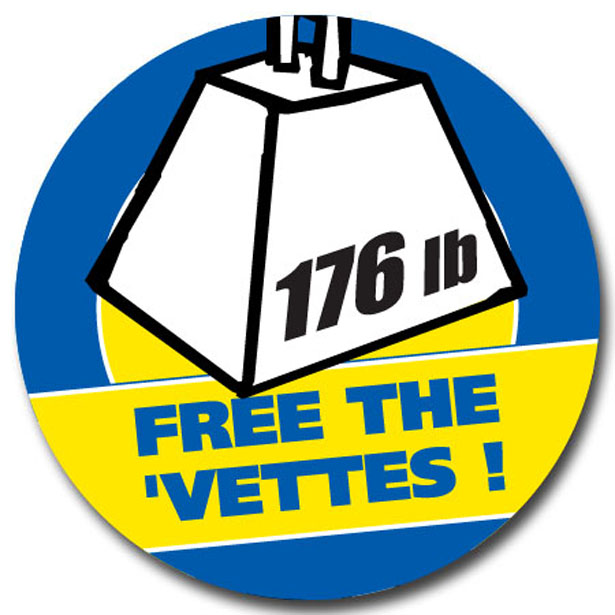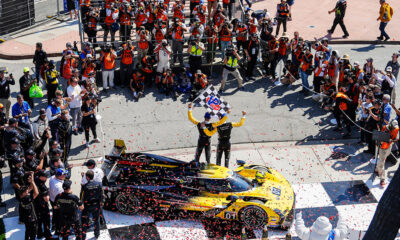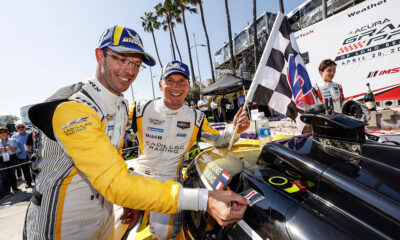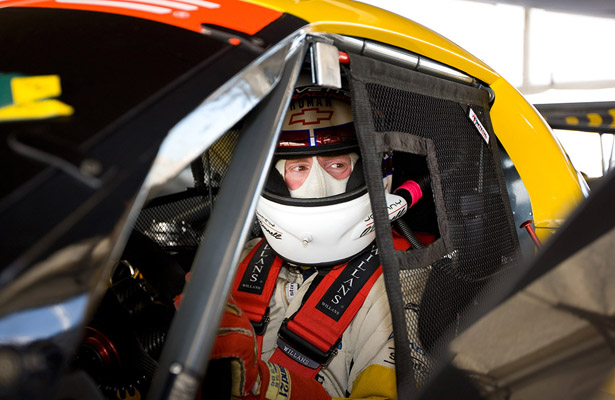
Photo: Richard Prince/rprincephoto.com
As Johnny O’Connell completed Corvette Racing’s first-ever lap on Michelin tires at Road Atlanta in October 2003, he made a surprising comment over the team radio: “The car is stable under braking,” O’Connell reported.
That brought a raised eyebrow from the Michelin engineer assisting with the test. Why was he commenting that the car was stable under braking? Wasn’t it always stable?
A Corvette Racing team member shook his head. “In the history of the program, the car has never been stable under braking,” he said.
When O’Connell, still running the car’s Petit Le Mans race set up, blasted down the hill and made the sweeping right turn onto the front straightaway at Road Atlanta, the increased Michelin grip level lifted the Corvette’s right front tire off the ground.
“Ya’all better get him back in here before you hurt something,” the Michelin engineer said.
Thus began one of the best examples of “knock-on” gains in recent sports car history.
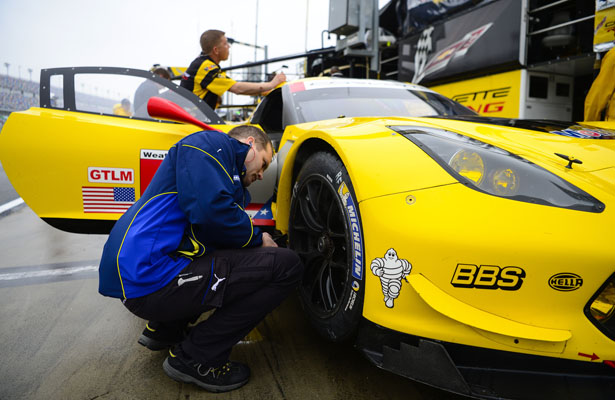
Photo: Michelin
Physics Made Easy
Sir Isaac Newton’s Third Law of Motion states, “for every action, there is an equal and opposite reaction.”
Racers offer a word picture, joking that “race cars are like Jell-O; you touch them here and they wiggle over there.”
Michelin engineers advise that a change of one-half pound of air pressure can impact spring rates, camber angles, tire temperatures, tread life, braking, corner entry and power down performance. Some of those impacts may be positive, others adverse.
Nothing happens in isolation on a race car. Any single change can produce other changes, some desirable, some not.
That is why racers typically prefer to make just one change at a time.
But what happens if you can find a change or combination of changes that together produce desirable reactions?
When a driver like Corvette’s Tommy Milner’s notes that after a chassis adjustment on his final pit stop at Road America, “the car came to life,” it often means that a positive change produced additional knock-on benefits.
So, why was the Corvette’s prior lack of stability under braking before the Michelin switch so important?
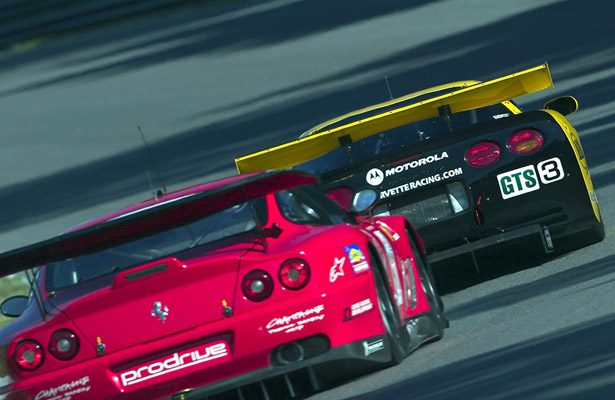
Photo: Richard Prince/rprincephoto.com
The Back Story
After class wins at Le Mans in 2001 and 2002, Corvette Racing was primed for a three-peat when it headed to Le Mans earlier in June 2003.
They came home stunned, having been thrashed by a staggering 10 laps (84.7 miles) by a Michelin-fitted Prodrive Ferrari 550 Maranello.
When Prodrive carried its success over into the American Le Mans Series after Le Mans and double-stinted Michelin tires to a victory at Laguna Seca, Corvette Racing leaders had seen enough. They approached Michelin about a test.
The day before Corvette’ first test, the Prodrive Ferraris finished 1-2 in GT1 class at Petit Le Mans, trouncing the third place Corvette by nine laps. Corvette Racing was ready to try big changes, including a new tire partner.
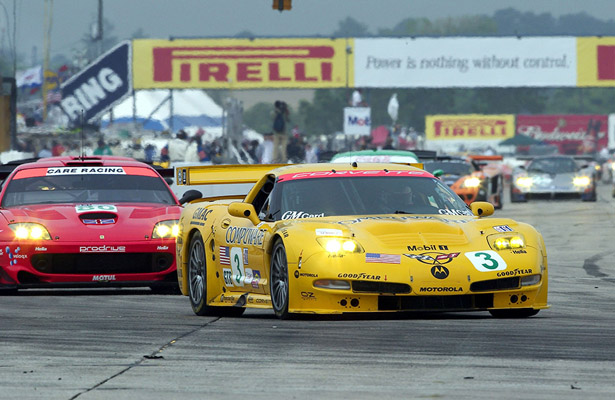
Photo: Richard Prince/rprincephoto.com
How Knock-on Gains Work
Ideally a single change not only produces a positive result, but enables another “knock-on” benefit.
During the first several tests with Corvette Racing, the Michelin and Corvette engineers produced an exceptionally long, daisy chain of enabled actions and positive reactions.
“We just started working together and finding more and more opportunities,” said Chris Baker, motorsports director, Michelin North America. “One thing led to the next.
“With the rear of a car more stable under braking, the driver can go deeper, trail braking into the corner resulting in a faster, more precise, corner entry as the car transitions weight to the front. This permits a quicker rotation and a straighter, faster exit.
“The higher exit speed means the car will achieve a higher straightaway speed or reach its terminal speed sooner. That, in turn, opens up better passing opportunities on the straights.”
But there is even more to be considered.
With the car more stable at braking and entry; and having a higher level of mechanical grip at mid-corner, the car requires less aerodynamic downforce.
A reduction in drag can further increase the straightway speed. That sees the car arrive at the braking zone sooner or at a higher rate of speed, helping to defend any attacks.
With the car being cleaner on corner entry and with less sideways movement and corner exit wheel spin, fuel economy and tire wear both improved.
Lap times soon significantly improved and Corvette also gained the ability to successfully double-stint tires.
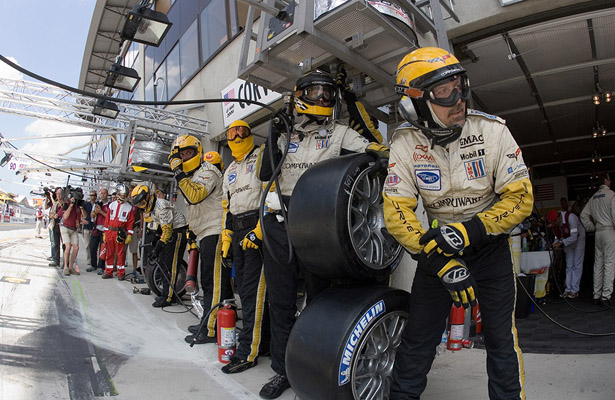
Photo: Richard Prince/rprincephoto.com
On the Timing screen
At Sebring that March, the difference in Corvette Racing lap times was three seconds per lap quicker than the previous year. At Le Mans, it was six seconds per lap.
At season end, team engineers reviewed every lap at every track for the entire year. The net gain equaled seven-tenths of a second per mile of track length from the previous year.
The first step in that massive gain came from stability under braking.
Opposite Reactions
Newton’s equal and opposite reaction law also plays out on the downside.
To illustrate how a negative knock-on situation unfolds, Risi Competizione Ferrari’s Rick Mayer recently agreed to walk through a large, hypothetical weight increase of 50kg (122 pounds).
“Increasing the vehicle weight means increasing the vehicle mass,” said Mayer. “The greater the weight increase, the greater the performance impact.
“Greater mass slows the car’s acceleration and increases braking distances. It also increases fuel use which is sometimes recognized in the BoP adjustment by increasing the fuel cell capacity.
“Brake and tire temperatures and wear will be increased and you may even need to choose a different tire compound.
“Continuing with your 50kg example, from the driver’s view, the car would be more sluggish to drive. If the car is no longer as stable under braking, the driver will likely fight understeer as he heads for the apex and then snap oversteer when he gets there.
“From a competition standpoint, the driver will be more vulnerable to attacks under braking and at corner exit and less able to make passes on the straightaways.”
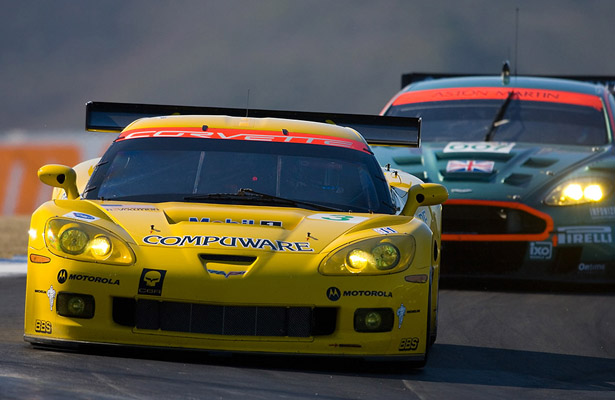
Photo: Richard Prince/rprincephoto.com
Knocked Down by Knock-ons
While that 50kg example seems significant, an even more extreme example appeared in 2006 when Corvette Racing was looking for GT1 class competition.
Aston Martin was willing to play in the former ALMS, but brought another tire maker to the ALMS and needed major performance adjustments to be competitive here.
The season opened at Sebring with Aston Martin enjoying a whopping 50kg/122-pound weight advantage.
By Houston, that weight differential was up to 176 pounds, prompting the appearance of “free the ‘Vettes!’” buttons.
The weight differential eventually grew to 198 pounds, nearly a 10 percent difference on cars that were equally rated for Le Mans.
“I only weigh 145 pounds,” Corvette Racing’s Jan Magnussen said recently. “Adding 198 pounds to our car would be like Antonio (Garcia) driving and having me fully suited up in the passenger seat with my big suitcase and my backpack.”
With the top eight GTLM cars posting best race laps within 0.524 seconds (0.42 percent) on the 2:03.6 (123.64 seconds) top GTLM race lap at Road America, Baker has a final take on knock-ons.
“The extent of the knock-on with that kind of weight (198 pounds) in the current GTLM competition would be that Jan could pack a cooler and lawn chair,” said Baker. “He would be a spectator.”
